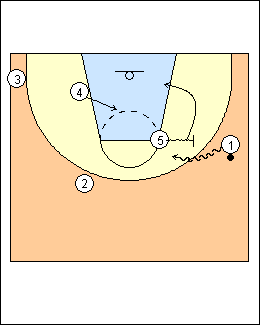Van Gundy ballscreens
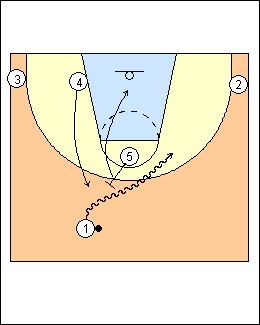 | 1 Jeff Van Gundy The pick and roll is the hardest thing to guard when executed properly, and gives the best shot with the fewest passes (lower risk of turnover). There are 6 types: 1) High 2) Straight-on 3) Spread 4) Shake 5) Side 6) Step-up 1) High As with any ballscreen, the screener head hunts, his back is towards the basket to force X1 over the screen. He sprints out, jump stops, right hand over left wrist, and gets wide, chest on X1's shoulder. The dribbler must create separation from his defender. e.g., from triple threat, rip the ball thru (over or under) away from the screen, crossover step past the defender, then step back with the ball; or off the dribble, knock the defender off (jab with the opposite foot). Make two dribbles off the screen before making a decision, but be selfish, it's for him. Multiple ballscreens on one possession are murder, e.g., a midscreen then sidescreen if the ball is swung from 1 to 4 to 3. Snyder and Rajakovic, FIBA Assist 41 - in many instances the preferred angle of a screen in the middle gives the ballhandler the use of his strong hand. Rautins and Pasquali, FIBA Assist 41 - only two dribbles are permitted during a pick and roll (or any one-on-one). Use only a crossover step to start a drive, a same-hand same-foot drive is considered traveling in Europe. Pick and roll is not just a play between the dribbler and screener, look to pass to a third teammate (concept of a triangle). When the offence gets a one-second advantage, they must try to maintain it by using good ball circulation until there is an opportunity for a free shot. In Europe the ball is always in movement and one-on-one opportunities are born thanks to good spacing. Coach K - come off the screen at a 45 degree angle (not too low, can't get a head of steam to turn the corner). If a big defender comes to help, shoot an extended lay-up (floater) from 7-8 feet, soft off the glass. On a hard show by X5, make a step-back dribble, turn the corner for a pull-up shot if X5 retreats (string him out, make him retreat or double team). Shoot from behind the screen if X1 goes under the screen (5 should roll and wipe him out). |
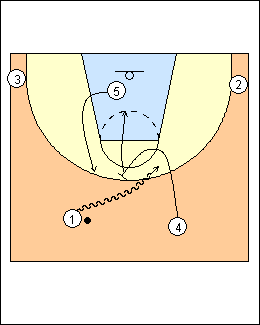 | 2 In transition, the first big runs rim to rim. Trailer 4's defender is likely back defending the paint, so a "drag" high pick and roll can take away the show. The ball is above the screen and 4 has his back towards the basket, so if X1 goes under the screen he recovers to 1 in the paint, and 1 is attacking the basket (not east-west) as he comes off the screen. 4 can pick and roll, or hold if a shooter. When defenders switch on a ballscreen, the Steve Nash or Dwayne Wade approach is to back it up on the dribble, come right at the guy's face at full speed, then make a move to get penetration. Posting up doesn't work. Another approach is to ballscreen with 4, clear him out, back up the dribble, and bring 5 into a second pick and roll. Heath Millar - European teams prefer to space and drive the big on a switch, rather than look to post the small. Rick Majerus calls this a double mismatch, you get the mismatch on the drive and a big on small rebounding mismatch if the shot is missed. Ryan Krueger - in transition, circle under the ball to set the right angle for the drag screen. Marc Iavaroni - a smart team will not attack the ball (show or blitz) when the pick and roll is outside the scoring area, they will just corral the ball. As a counter, the screener gets below the ball then below the on-ball defender (a fish-hook screen), where going under the screen makes no sense. Also set a fish-hook screen against attacking or switching ballscreen defence. |
 | 3 If a screener can't catch and score on the roll, use him as a screener on the roll. False action brings defenders off of attackers' bodies, with more chance of mistakes. |
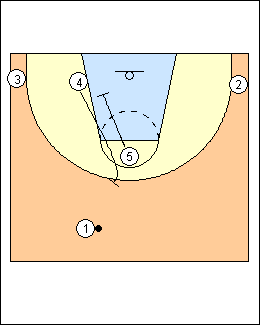 | 4 Bringing a ballscreen on the run takes away the "show" by the screener's defender, can do this at any angle. |
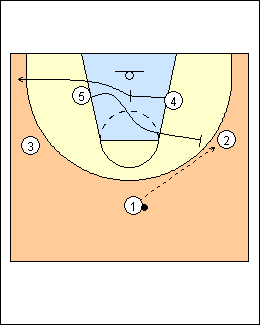 | 5 |
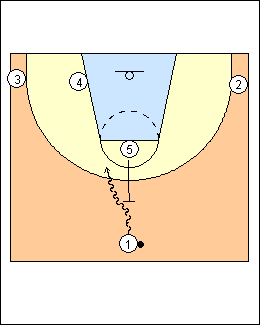 | 2) Straight On The ball is in the middle, the screener has his back to the baseline, adjusts the screen slightly at the last second to create a driving angle. One of the hardest ballscreens to guard, and useful with a "jet" point guard who can't shoot. You will often get drive-aways opposite the screen because the defenders don't know which side is being screened. Phoenix will have 5 re-screen if you force Nash to his left. |
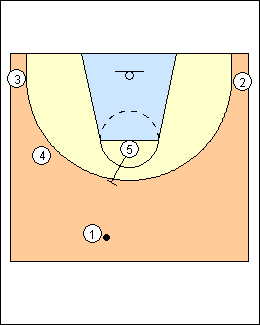 | 3) Spread The most difficult pick and roll to guard. Greece used it against the US. A lot of NBA teams are going to a 4-out, 1-in set (e.g., Phoenix). If perimeter players space 2-3 steps outside the 3-point line (play off the line), they can do a rhythm 1-2 step into a shot. |
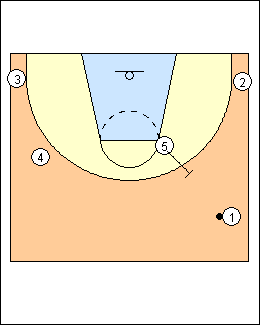 | 4) Shake The ball is at the 28-foot hashmark, the screener comes up from the elbow, creating a bigger driving gap. Snyder and Rajakovic - an inside ballscreen sends the ballhandler toward the middle of the floor, an outside ballscreen sends him toward the near sideline, a flat ballscreen is perpendicular to the basket. |
 | 9 For a shake pick and roll on the run, have 4 screen for 5 then spread to the corner (if a shooter). |
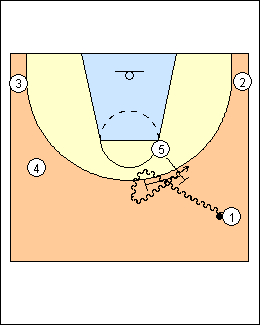 | 10 To create two picks on the same play, 5 ballscreens for 1, who comes off the screen and bounces it out, then 5 re-screens. |
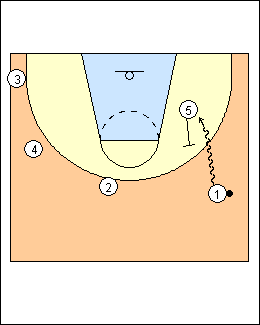 | 6) Step-Up The screener comes up from the baseline, and the dribbler goes baseline off the screen. |
This page was made with Basketball playbook from Jes-Soft

